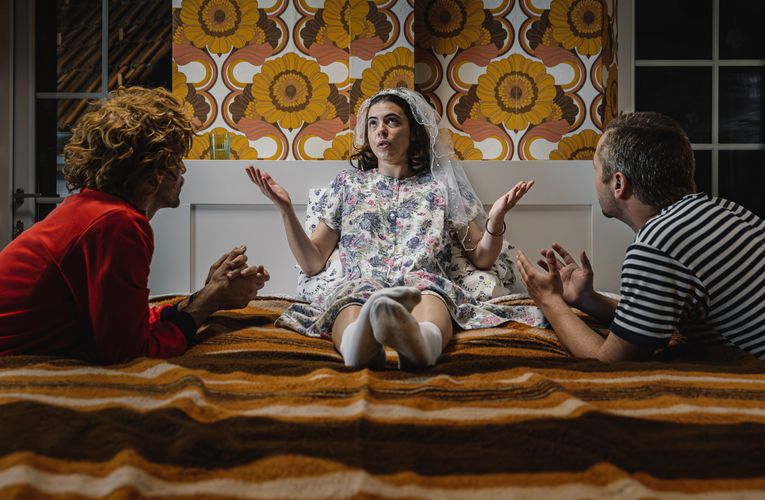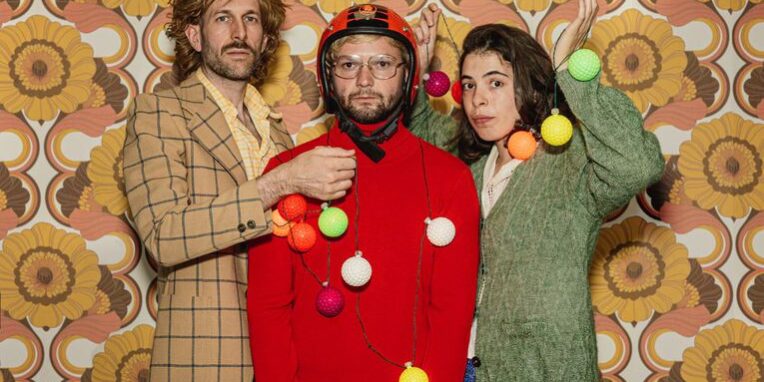Ustvarjalni center Krušče, premiere 30th August 2025
A performance for one room and three actors. This is the best way to describe Tomi Janežič’s 1979 and 1980, a double performance that is minimalist in form but rich in plot. The productions continue the large-scale Dodekalogija project, created as part of European Capital of Culture 2025 – Gorizia and Nova Gorica. The entire project aims to tell the complicated history of the region shared by the two cities. In these parts, unlike the very Slovenian 1974, it is the Italian side (more precisely, a small village) that becomes the main setting of the action.
A recurring element that connected the previous performances was the Italian actor Carlo Zoratti, who appeared on screen, in pre-recorded footage, talking about the real-world locations in which the stories within the performances take place. This time, Carlo is on stage, and the plot revolves around his family: friends, parents, grandmothers, and grandfathers.
Carlo plays the roles of both his father and grandfather at different stages of their lives. Another bridge to the earlier parts of the project is Stane (Stane Tomazin, as in previous performances, the main characters bear their actors’ names), known from the previous performances as Aunt Damjana’s nephew. This time, however, the actor brings us closer to the story of Stane’s childhood, as well as that of his stepfather – a local inventor of Velpro tape, and his older friend Poldo, who was injured in an explosion and becomes disabled for the rest of his life. The nurse who cares for him is Anuša (Anuša Kodelja), also known from other performances, a deaf girl who developed a Morse-code-based way of communicating with the victim of the explosion. :Anuša Kodelja, also plays several other powerful female roles, including the paralyzed Saint Concetta, who prayed for a marriage for her sister, and Carlo’s grandfather, both of Carlo’s grandmothers, and Miriam, the owner of a bar.
As in the previous productions, the actors – together with the director – guide us through the private stories of the characters, adding new information to the genealogical tree created for the Dodekalogija. And, just like before, they do it with warmth and emotion. The atmosphere of the performance is therefore similar to the others. The audience can listen to personal stories that build the broader context of the region and the decades in which they take place. The quality of the storytelling is no different, in fact, it draws the viewer back into the saga of the family they have already heard about, allowing them to once again immerse themselves in the world of the 70s.
The cohesive scenography by Branko Hojnik and the costumes by Marina Sremac also help to locate us in the 70s. As before, the set and costumes capture the spirit of the era and transport us into the past. In the case of the scenography, Branko Hojnik did not have much room to experiment, since the main performance space of the Krušče Creative Center is small. Still, the choice of colourful wallpaper and a few characteristic objects of the time is enough to build the world. Because there are so few actors, the costumes serve not only to evoke a different world but also to distinguish between the characters played by a single performer. Each actor has at least three roles, and what differentiates them is sometimes their manner of speaking, but usually the costume and the wig. And although this could have easily become chaotic or confusing, it is not at all. The viewer can immediately recognize which character they are encountering.
What sets 1979 and 1980 apart from the other productions in the project is their scale. The room in which the performance takes place is small, roughly the size of a large living room, with a bed, a table, and other objects brought onstage as needed. Such a limited space forces specific staging solutions. Whereas in the earlier parts, the driving force was the characters, here, due to the tight space, the objects that drive the story. They are not only more visible in such an intimate setting but they also provide an interesting narrative device that allows the focus to remain on the spoken word and the storytelling, rather than on elaborate stage choreographies. Thus, through a Happy Meal toy, we learn the story of Carlo’s grandmother and the mourning after her death, and through a painting and a coffin we discover what kind of person his grandfather was. Although simple, this device fits remarkably well with the nature of family stories, which often unfold in exactly this way. We learn about our ancestors through the material objects they leave behind. Here, the orally transmitted story is combined with the kind that conveys knowledge of the past through artifacts.
There are no dance scenes or any major choreographic arrangements in 1979 or 1980, the two performances are, above all, masterpieces of storytelling. The Krušče Creative Center is not an institutional theatre, it is a residency centre co-run by the director, who often collaborates with institutional theatres. In these performances, the centre does not try to be anything other than what it is. In their form, the two pieces resemble off-theatre or independent productions rather than the large-scale works like the previous Dodekalogija performances. Krušče lacks professional stage lights. Instead there are simple lamps which are turned on and off by the director. There is no technical booth. In fact, there is no technical crew at all – the director sits among the audience and manages the lighting, music, and subtitles himself. This experiment with space is extremely interesting from the perspective of the entire project. 1979 and 1980 provide a far more intimate encounter with the protagonists and a reflection of the atmosphere of small-town life and their sense of isolation from the events of Big History.

1979 and 1980. Photos: Guido Mencari
The director, Tomi Janežič, also appears in the performance as… himself. He interrupts the actors’ lines, comments on what they are saying, or comes onstage to read a letter from a woman who saw previous performance. He is also a kind of narrator, adding global context to the years 1979 and 1980 by reading out what happened in those years. He is a co-creator and a guide through the performance, helping to clarify the context or a character. One of the most recognizable director-figures who intervened in his own performances was Tadeusz Kantor, who walked across the stage telling actors what they were supposed to do next. His stance, however, was distanced from the performance and visibly hierarchical in relation to the actors. Tomi Janežič presents himself as something like an anti-Kantor, a director who does not command but creates together with the actors.
The way the piece deals with disability could be the topic of a separate essay. In the field of theatre studies there are ongoing debates about who can portray characters with disabilities and how they should do it. The recurring question is: should disabled characters be played on stage by non-disabled actors? There is a term ‘cripping-up’ that means casting an actor without a disability into a role of a character with a disability. This what happens in 1979 and 1980. While the best solution would be to hire actors with disabilities, which would also help disabled performers gain employment, this is not always possible, so it is important to develop respectful methods for performing such roles.
Tomi Janežič does not avoid this subject; instead, he introduces not one but several characters with various disabilities. There is Concetta, but also the mute Anuša, who communicates with Stane in sign language. There is also the injured friend, left without arms and legs. Choosing to present identities that fall outside the norm was a bold move on the part of the creators, but in my opinion, an important one. It is important first of all for visibility and representation. Including characters with disabilities in such a large project can increase the audience’s awareness and sensitivity. It is also significant from a theatrical and educational perspective because it can show other creators that characters with disabilities can be portrayed authentically and with respect. Concetta suffers from a condition that causes her to speak with a clenched jaw. Anuša Kodelja builds from this a fully developed character, one who is likable and, perhaps most importantly, not pitied. We do not see Concetta through the lens of her disability, but through her accomplishments as a local saint. In Poldo’s case, the creators developed a new approach that, thankfully, does not involve an actor walking on their knees or pretending to have no arms. Instead, the director explains that in the hospital Poldo will be represented by a sculpture, which “breathes’’ when switched on. This does not dehumanize the character in the way some other prop might. The creators present disability in a way that goes beyond a binary understanding of normality and otherness.
Having now seen several performances in the Dodekalogija series, it is clear that it is not just an ode to the cities of Gorizia and Nova Gorica. It is an ode to theatre and theatricality itself. To the theatre of stories, the theatre of scenography and costumes, the theatre of the actor, and theatre that creates the hard-to-define magic of theatre in its purest form. Together, the performances of the Dodekalogija series contain the warmth of grandmotherly tales handed down, stories that cannot be forgotten, just like the world created by the artists, a world in which we want to remain.
Credits:
Director: Tomi Janežič //Set design: Branko Hojnik//Costume design: Marina Sremac//Music: Samo Kutin//Sculpture design: Nenad Gajić//Lighting design: Tomi Janežič, Branko Hojnik//Sound design and music selection: Tomi Janežič
Cast: Anuša Kodelja, Stane Tomazin, Carlo Zoratti, Tomi Janežič
Co-production: 1979: GO! 2025 – European Capital of Culture (part of the official programme of GO! 2025), Krušče Creative Center and SNT Nova Gorica // 1980: GO! 2025 – European Capital of Culture (part of the official programme of GO! 2025), Krušče Creative Center, SNT Nova Gorica and Mladinsko Theatre
For more information, visit: Krusce.si
Further reading: Review of 1974
Further reading: review of 1978
Further reading: Review of 1981
Karolina Bugajak is a theater critic from Poland, currently living in Ljubljana. She studied culture and contemporary art at the University of Lodz. The title of her master's thesis was "Theatricality and Exaggeration. Camp aesthetics as a strategy for creating new identities in the plays of Grzegorz Jaremko". Her main theatrical interests include topics such as institutional criticism, the representation of marginalized groups in plays, and most recently the theater of the former Yugoslav states.








